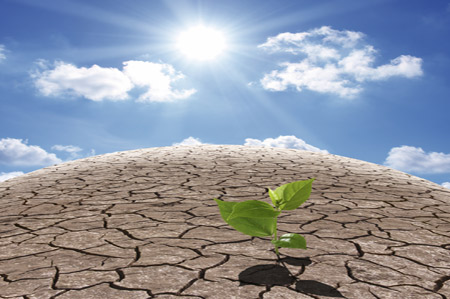California’s Growers Bear Brunt of Drought Woes
Category: Miscellaneous, Weather
 (Wall Street Journal) – California’s historic drought is forcing farmers in the dominant produce-growing state to fallow hundreds of thousands of acres and spend millions of dollars to access water. Yet U.S. grocery shoppers are barely feeling an impact.
(Wall Street Journal) – California’s historic drought is forcing farmers in the dominant produce-growing state to fallow hundreds of thousands of acres and spend millions of dollars to access water. Yet U.S. grocery shoppers are barely feeling an impact.
Average retail prices for fresh fruits are down 3% so far this year and vegetables are up 1%, according to federal data. That compares with a nearly 2% gain in overall U.S. food prices.
The lack of pain in the produce aisle highlights a tough reality of the produce business: It is difficult for growers and packers to boost prices because the sector is so fragmented, giving retailers and other wholesale buyers many options.
When U.S. farmers cut output, increased imports from Mexico, Chile and elsewhere have helped fill the gap. Prices also have been kept low because some California farmers have shifted fields to fruits and vegetables from more water-intensive crops like grain.
The lack of price leverage is further squeezing profit margins for California fruit and vegetable suppliers wrestling with rising costs for water, labor and other expenses, industry executives say.
“The improvement in pricing has not been anywhere close to the increase in raw input costs and the cost you get stranded with when you have such a large percentage of your land unplanted,” said Steve Hamm, controller for Harris Farms Inc., a grower of tomatoes, lettuce and other crops in the San Joaquin Valley.
Operating profit margins at Harris Farms have narrowed by double-digit percentage points since 2013, Mr. Hamm said. The company is planting crops on only a quarter of its 14,000 acres, yielding less revenue to cover its fixed costs.
In fact, prices that farmers fetch for fruit have fallen faster than those in the grocery store, exacerbating margin pressures. The USDA estimates that farm-level fruit prices will decline as much as 6% this year, while vegetables will be unchanged to down 1%.
Industry executives say consumers could see higher produce prices if the California drought—now in its fourth year—persists, causing greater crop damage and prompting farmers to leave more land unplanted.
Some large produce growers warn that things could get worse. Harold Edwards, chief executive of Limoneira Co. , a lemon-and-avocado producer, told investors last month its operations haven’t been “significantly affected” by the drought, but that costs increased for irrigation and crop treatment and Limoneira had to be “more strategic in our water usage.” He said the Santa Paula, Calif., company could suffer if the dryness worsens or government agencies impose further water restrictions. Farms face varying water-usage limits, depending on their location and level of water rights.
The drought is having an uneven impact on California’s $45 billion agricultural economy. Farms in coastal regions, such as the Salinas Valley, generally have a more-temperate climate and better access to water from local aquifers than those in Central California. Many growers in the parched San Joaquin Valley are spending heavily to pump groundwater from depleted aquifers.
Statewide, farmers this year will spend about $590 million more to pump groundwater than the $780 million they spend in an average year, according to the Center for Watershed Sciences at the University of California, Davis. It also estimates the drought will prompt farmers to fallow an additional 542,000 acres—a 45% increase over a typical year.
Many California farmers are focusing on crops that generate greater returns on their water usage. They are growing less rice, alfalfa and cotton—commodities for which California has many competitors—and more grapes, almonds and other crops in which the state has big market shares and strategic advantages.
That has helped mitigate the drought’s impact on California fruit-and-vegetable output. The USDA forecasts that the state’s production of grapes, strawberries, tangerines, pears and “processing” tomatoes—the kind used in pasta sauces and soups—will see a rise this year.
Meanwhile, the strong U.S. dollar has helped boost imports of produce such as cantaloupe and oranges because foreign growers can earn more selling to American buyers.
“California dominates, but there’s increasing production in other areas,” including Mexico, said Heather Jones, an analyst with BB&T Capital Markets.
The increased competition worsens the challenge for Turlock Fruit Co., a Fresno County producer of melons, asparagus and tomatoes that has fallowed about 900 of its 3,000 acres. Profit margins are down because “you have a great deal of land that is not producing any revenue” and wholesale prices have been limited by “pure supply and demand,” said co-owner Steve Smith.
Ocean Mist Farms, the biggest U.S. artichoke grower, has struggled to pass along increased costs related to the drought, said Joe Pezzini, chief executive of the 91-year-old Castroville, Calif., company.
Yields on its artichoke crop fell sharply during the spring, he said. The company also has spent more on pesticides and other crop protection to combat insects that are more potent in the drier climate. “Prices certainly went higher” but “didn’t compensate for the loss in yield,” he said.
California growers see some reason for optimism in forecasts suggesting a strong El Niño weather pattern in the Pacific could bring drenching rains this winter.
“We are just hoping and praying that happens,” Turlock’s Mr. Smith said.




